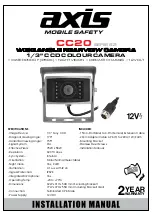
IL3 User’s Guide
page 48
11S-3002B
•
If the Master Sync Out is Active High, then the Slave Sync In must be set for Rising Edge. If
Master Sync Out is Active Low, then the Slave Sync In must be set for Falling Edge.
NOTE: For the “common” setup as well as for variations listed below, always make sure that the Post
Trigger portion of the recording time for the Master camera is equal to or greater than each of the
Slave cameras. This is important because Sync Out pulses cease with the completion of the capture,
so the Master camera must continue recording until all Slave cameras complete their recordings.
Parameters that affect post trigger recording time include: Trigger position, Resolution, Bit depth,
base internal Memory (camera model), Frame rate.
Variations on Master/Slave:
•
Use a slower frame rate for one or more of the slave cameras by using a Rate Divisor in the Sync-
In setup. (Make sure to make allowance for the extended time per the note above.)
•
Extend the overall record time by adjusting the trigger position for all cameras. For example, set
the Master to a Start trigger, the first Slave to 10%, the second Slave to 50%, etc. This would also
be used if the subject is progressing through the different cameras’ fields of view, as a runner
running by each camera in sequence.
•
Run cameras out of phase with each other. Higher effective frame rates can be simulated by
running cameras out of phase with each other. This is usually done by using Duty Cycle in Sync
Out, for example: if you set the Duty Cycle for 50% and invert the signal, the next camera in line
will run 180 degrees out of sync.
Figure 5-8:
External Sync: Local Grouping
















































